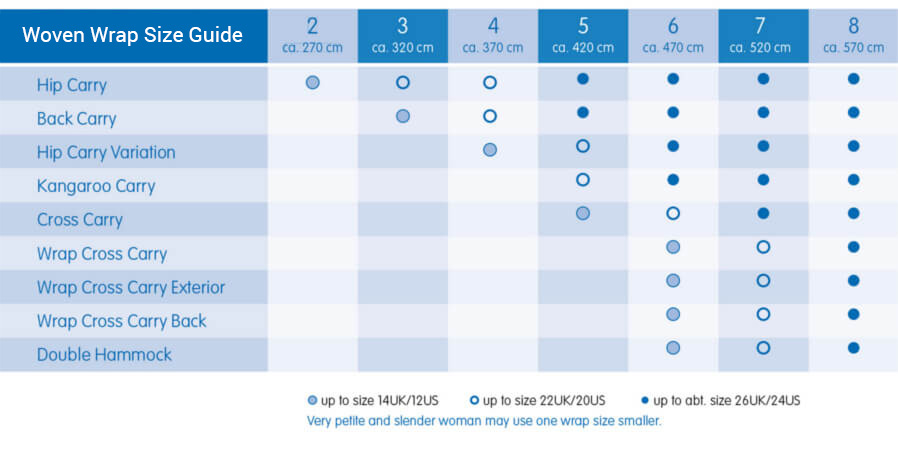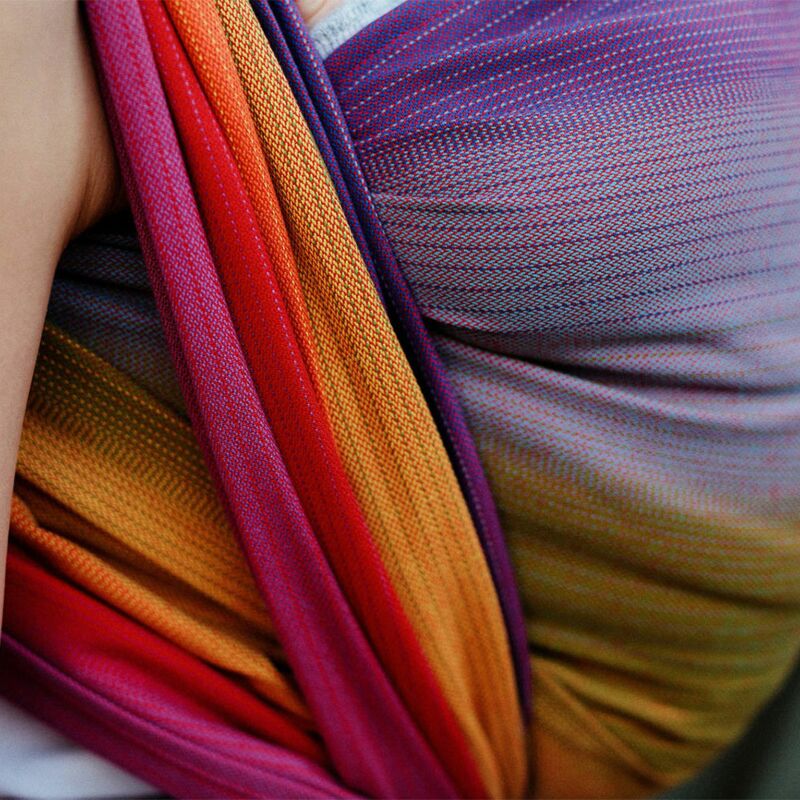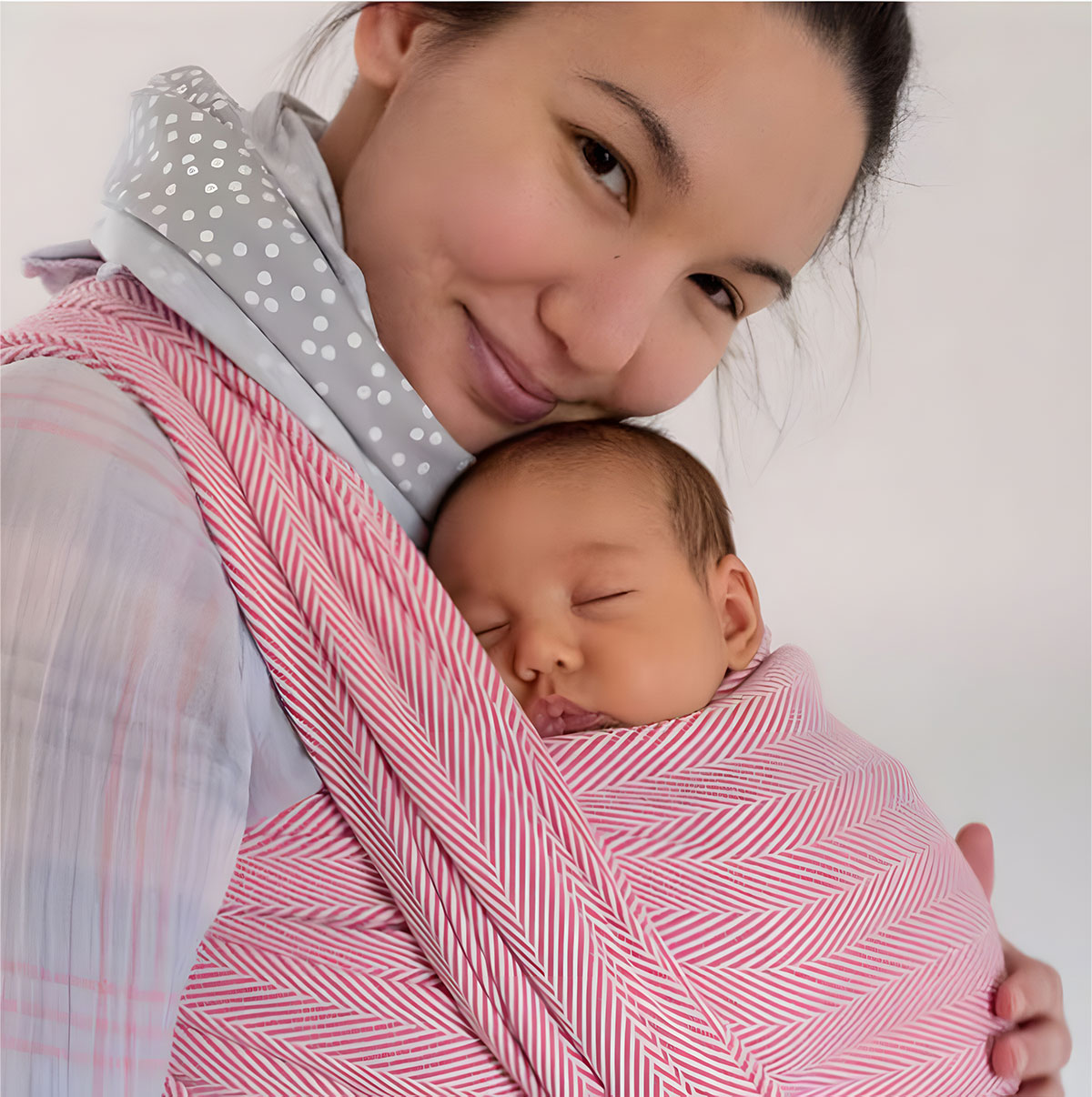Woven Wrap Buying Guide
![]()
by Beth Beaney, Executive Babywearing Consultant & Co-Founder, LTBN
Woven wraps are great for newborns, babies and toddlers alike, but which should you buy for your little one? Help make choosing your woven wrap easier with this handy buying guide.
What Is A Woven Wrap?
Woven wraps are similar to stretchy wraps in that they comprise one long piece of fabric with no buckles, fasteners or rings.
Woven wraps can be tied in different ways for different carries. They differ from stretchy wraps in that woven wrap fabric is far more supportive. Woven wraps have a slight diagonal stretch, making them firmer than stretchy wraps - supportive enough to hold a heavy toddler.
As such a woven wrap sling can work for all sizes and ages, from one-week old until your child grows out of being carried, i.e. when they're a toddler.
You can adjust the sling to carry your baby in different ways as they grow and develop. Once you wrap it around, the sling holds your baby safely and securely in a way that promotes their development, is respectful to baby’s physiology and is healthy for their hips.
Woven wraps can be tied for front, back and hip carries. If you've loved using a stretchy wrap for your baby, then a woven wrap will allow you to continue wrapping with a larger, heavier baby, toddler and child.
Woven baby wraps are a beautiful way to carry your little one. There is a sort of ritual to wrapping; the cloth, the movements, the finish. It can seem daunting - the long length of fabric, without structure, and yes, there is a learning curve with it, for sure. However, the lack of structure is exactly what makes a woven wrap so versatile. It can be used with even the smallest babies all the way to preschoolers. Which also means a woven wrap is pretty much the most economical, cost-effective sling to use.
Carrying your baby in a woven wrap is an elevated babywearing experience.
It's babywearing in its purest form.
Your child can use the wrap as a plaything when you're done using it for babywearing, and it can even be handed down to the next generation as woven wraps tend to be heirloom quality.
Why Do Woven Wraps Come In Different Lengths?
Woven wraps are available in several lengths, most commonly in sizes 2-7 (shortest to longest). The length you choose depends on the carries you’d like to do (singe layer / multi layer), and your dress/shirt size. If you’d like a wrap to last from newborn to toddler +, with the most versatility, opt for either a size 5 (4.2m), size 6 (4.6m) or a size 7 (5.2m) (also known as your base size) - use the size guide here to work out which of these is your base size.
There is a learning curve with wraps, but it's definitely worth it. All come with detailed instructions, and we are always super-happy to advise and provide guidance on which wrap is best for you. Woven wraps come in different sizes: Size 1 (2.2m); Size 2 (2.6m); Size 3 (3.2m); Size 4 (3.6m); Size 5 (4.2m); Size 6 (4.6m); Size 7 (5.2m); Size 8 (5.6m).

Woven Wrap Blends
Woven wraps are most often found in 100% cotton options. Cotton is easy to care for, easy to wash and dry and suits babies of all ages.
There are also lots of different wrap blends: 100% Cotton; Cotton / Silk; Cotton / Wool; Cotton / Hemp; Cotton / Linen; Cotton / Alpaca; Cotton / Cashmere; Cotton / Bamboo, are a few examples.
Woven Wrap Weaves
As I mentioned, the most popular and easiest to care for options are woven wraps made from 100% cotton, and there are several different weaves to choose from:
- cross-weave;
- diamond weave;
- herringbone, and
- jacquard.
1. Cross Weave
This is used extensively, producing beautiful stripes and uni-colour wraps. They can have a firmer feeling initially, but soften with use to produce wraps that work well with newborns and toddlers alike.

2. Diamond Weave
This produces a diamond shape within the weave. It lends itself to rainbow tones as it creates a shimmery-ness and is usually softer in-hand straight away than the cross-weave.

3. Herringbone Weave
This produces a distinctive 'V' shape in the fabric. It works well in rainbow tones and stripes to produce a dual effect of colour and pattern, but also works beautifully with two colours, producing a soft-flowing pattern which is quite striking. Usually quite soft in-hand immediately, particularly the Lisca range of wraps from Didymos.

4. Jacquard Weave
This process produces some of the most intricate, delicate and bold designs that you'll find, enabling the weaver to produce highly detailed designs whereby the pattern is woven into the fabric producing detailed images or patterns. Jacquard wraps can be a little firmer in hand to begin with, but when wrapped with, produce the most stunning effects - for example, flipped shoulders, or seeing both the top side and reverse in one carry.

How To Use a Woven Wrap
There are dozens of different wrapping techniques. You can learn one, or you can learn few - it’s completely your choice. You know yourself what will work for you and your baby.
One of the advantages, and indeed beauties, of wrapping is that there is so much versatility. Unlike a buckle carrier, for instance, which tells you how it works, and often only works one way (i.e. you tie the waist belt and you tie the shoulder belt), a woven wrap is just a piece of fabric - it's up to you how to work out how to tie it! in this way, there is a deep sense of achievement when babywearing with a wrap - there is a deep connection with the wrapping process and deep connection with your baby.
Let's look at the different ways you can carry your baby in a woven wrap. The versatility allows you to carry your baby on your front, on your hip and on your back.
Carrying Your Baby on Your Front
1. Front Wrap Cross Carry

The front wrap cross carry (FWCC) is the ‘go-to’ position that most parents start with. It’s a superb option for carrying newborns or premature babies and even toddlers. Three fully adjustable layers of fabric support your child’s weight, holding their little head and body steadily on all sides. You can provide an additional neck support by rolling a muslin cloth or similar into the top edge of the sling, creating a “collar” that reaches up to the back of your child’s head.
The wide fabric bands distribute the weight very evenly across your shoulders, back, and hips, enabling you to comfortably carry a bigger child too, all the while maintaining an upright posture that protects your back.
Baby's position: upright on your chest.
From age: from birth upwards.
Wrap size: suitable from size 5 upwards.
Pro Tip: For bigger babies who already have good body control, you can also spread the lateral bands over their bottom. This further eases the load on you and makes it easier for you to carry your baby.
2. Kangaroo Carry
The Kangaroo Carry is a front carry and a lovely option for younger babies. It’s a single layer carry so it’s light and airy. The shoulder flip cups your shoulder, spreading the weight across a greater area. A slightly shorter wrap can be used for this carry.
Baby's position: upright on your chest.
From age: from birth upwards.
Suitable for wraps: size 4 upwards.
Pro Tip: After flipping the shoulder fabric, don’t over tighten the upper rails on the wrap in each hand - this is the fabric that sits under baby’s bottom creating the pouch. Over-tightening will cause the seat to narrow.
3. Front Cross Carry
With the Front Cross Carry position you wrap a flat fabric cross on your back instead of a knot. This gives you the advantage of being able to sit down comfortably on the bus or train, or when playing with their siblings. It also allows you to carry a rucksack on your back if you’re going on a walk or doing some shopping.
Baby's position: upright on your chest.
From age: 12 weeks upwards.
Suitable for wraps: size 5 upwards.
Pro Tip: This a cooler option for baby, as there are only 2 layers supporting them. Try using a sling ring to thread through the two passes on your back - it works a treat to help adjust and tighten the fabric.
Carrying Your Baby on Your Hip
1. Simple Hip Carry
For many parents, carrying their child on their hip is a completely natural and almost automatic thing to do. This is also true for the baby, whose reflex is to clamp on with their legs. It provides even support for your baby’s back, which is particularly important when they can’t yet sit up unsupported.
Baby's position: upright on your hip.
From age: 12 weeks upwards.
Suitable for wraps: size 1 upwards.
Pro Tip: This is another cool, single layer carry, so a great option for warmer weather and baby’s who run warm. With younger babies, be sure to walk enough fabric up baby’s back so they are fully supported, and tighten piece by piece across the width of the wrap.
2. Robin's Hip Carry
This is a wonderful hip carry - super supportive, so a really great option for toddlers. Particularly good if you already have a longer length wrap - this carry will work really well with it. The Robin’s Hip Carry boasts a comfortable fit, as the fabric layers are doubled up over your shoulders. The knot and the cross also support your child’s bottom.
Baby's position: upright on your hip.
From age: 12 weeks upwards.
Suitable for wraps: size 4 upwards.
Pro Tip: The great thing about this hip carrying position is that if it isn’t quite as snug or comfortable as you’d like, then you can adjust it afterwards simply by undoing the knot and feeding the fabric in strands, piece by piece, from one edge of the wrap to the other.
Carrying Your Baby on Your Back
1. Rucksack Carry
As your baby’s gradually getting bigger and you find you need a little more freedom when carrying, then why not give the rucksack carrying position a try?!
It enables you to carry your child in an ergonomically healthy way, whilst they watch everything going on around them, and best of all, they’re still connected to you, as they are parent-facing.
Tying your carrier in the rucksack position takes a bit of practice, as with most things in life. If you have a sling in size 4 or above, you can tie the woven wrap ends around your stomach once your child is sitting securely on your back, for even greater carrying comfort.
Baby's position: upright on your back.
From age: a few weeks onwards (with guidance).
Suitable for wraps: size 4 upwards.
Pro Tip: Rather than tying the wrap off at your waist, cross each end over to the opposite shoulder and hook the fabric behind the shoulder strap, pulling out at the inside of your chest. No need to knot now - although there are lots of fancy fishes that can be achieved using this method.
2. Backwrap Cross Carry
The back wrap cross carrying (BWCC) position is a good option for active babies who like to leg-straighten and bounce when being wrapped. Three layers of fabric hold your child particularly closely and securely on your back, making the carrying experience more comfortable and secure for both of you.
Baby's position: upright on your back.
From age:12 weeks onwards.
Suitable for wraps: size 6 upwards.
Pro Tip: Spread the second and third layers of the wrap out on your back as wide as possible in order to support baby as widely as possible.
3. Double Hammock
In the double hammock position, you carry your baby in a multi-layer carry, in a similar way to the rucksack carrying position. The particular feature of the double hammock position is that you tie your sling with a wide band of fabric across your chest, providing additional support for carrying your child’s weight.
Baby's position: upright on your back.
From age: 6 months onwards.
Suitable for wraps: size 6 upwards.
Pro Tip: The double hammock carry takes a little practice as there are several layers, each needing adjusted through, but the practice is worth it - it's a great option for bigger babies.
Using a Woven Wrap With a Newborn
When your baby arrives, adjusting as a family and adapting to the changes can be challenging.
A woven wrap can make this transition simpler - babies are calmed when next to you, they hear your heartbeat, they smell you, & feel you. And it's the same for you - you feel them, hear them, smell them. In doing this, your body produces oxytocin, and this has positive effects on baby and on you - your mental health, and your emotional and physical well-being. It’s a wonderfully human action, and it’s for everyone.
Woven wraps are fantastic option for your newborn. There are no buckles or clips or fastenings; it’s soft fabric all over.
There’s no guessing how much to cinch or adjust; how much webbing to tighten or adjust. It's a wonderfully intimate way of carrying your baby - you have learned how to turn one piece of fabric into a method of carrying your baby. Unlike a buckle carrier for example, a woven wrap doesn't tell you how it is to be used - it's up to you to learn how to use it and to practice. In this way, using a woven wrap to carry your baby is in some ways even more special and more meaningful.
The woven wrap fabric will mould to baby’s shape and form. It will fully support their body and be completely respectful of their newborn physiology. This means your baby doesn't have to bend to the shape of the carrier. It really is a gentle transition from womb to world.
Using a Woven Wrap With a Toddler
The size of a toddler alone can make carrying no easy feat. But sometimes they absolutely need a 20 minute nap/rest and using a woven wrap to carry your toddler is a great way to manage it. They can be heavy, yet much lighter than in arms and ultimately, they'll likely be a happier child for that little reconnect and nap.
Such meaning - it’s deep bonding that lasts. Carrying a bigger baby or older child in a woven wrap can have a profound and lasting impact on you both. It's never too late to start carrying. How long you carry for, is completely up to you both. It may be every day, it may be now and again. It may only be when they are poorly or as an out-the-blue-hold-on-you-haven't-been-carried-for-years surprise. It doesn't matter - it's closeness, it's deep bonding and it's absolutely cup-filling!
One of the most wonderful aspects of using a woven wrap is that the very same wrap that you used with your newborn may also be used to carry your toddler. In this way, a woven wrap really can be the most economical carrying method - one wrap from newborn to preschool. The same wrap can then be used to carry another child, or as a blanket on their bed when they're older. Indeed, they'll be able to use the same wrap to carry their own children.
Shop Woven Wraps
I hope you found this article helpful. Please get in touch or email me - beth@lovetobenatural.co.uk - if you'd like any further info on woven wraps or babywearing in general.
Beth Beaney is the Founder of and Executive Babywearing Consultant at LTBN. She's been a qualified babywearing consultant for 12 years, and has helped thousands of families of all needs carry their babies safely and comfortably. Find her on Twitter @lovetobenatural_LTBN
 5,467 Reviews
5,467 Reviews






















